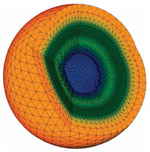Department of Physics and Astronomy: Publications and Other Research
Date of this Version
2-13-2013
Document Type
Article
Citation
PHYSICAL REVIEW B 87, 054410 (2013)
DOI: 10.1103/PhysRevB.87.054410
Abstract
Multiferroic nanomaterials bear the potential for assembling a manifold of novel and smart devices. For room temperature (RT) applications, however, only the BiFeO3 single-phase perovskites are potential candidates to date. Nevertheless, vertical heterostructures separating magnetic and ferroelectric functionality into different layers are now widely proposed to circumvent this lack in materials' availability. We show here that the second approach is very profitable as illustrated by the strain-mediated coupling between such two layers, i.e., a ferroelectric barium titanate single-crystal (BTO) and a magnetostrictive nickel (Ni) thin film. Applying an electric field across the BTO substrate forces the magnetic easy axis in the Ni film to rotate by 90 â̂̃, resulting in a magnetic anisotropy in the range of -1.2 to -33 kJ/m3. We show that local switching proceeds through the nucleation and growth of straight Néel-domain walls at a cost of zigzag walls. The process is fully reversible and continuously tunable as investigated with magnetooptical Kerr microscopy and magnetic force microscopy probing the local in-plane and out-of-plane magnetizations, respectively. Moreover, the degree of anisotropy can be pre-engineered by depositing the Ni film either at RT, above the Curie temperature Tc of BTO, or at an intermediate temperature. Our findings give evidence for using the reported coupling in modern devices, such as magnetoresistive random access memories, spin valves, spin-polarized electron emission, but equally for the bottom-up assembling of magnetizable molecular nanostructures through magnetic domain wall engineering. © 2013 American Physical Society.
Included in
Atomic, Molecular and Optical Physics Commons, Condensed Matter Physics Commons, Other Physics Commons


Comments
©2013 American Physical Society. Used by permission.